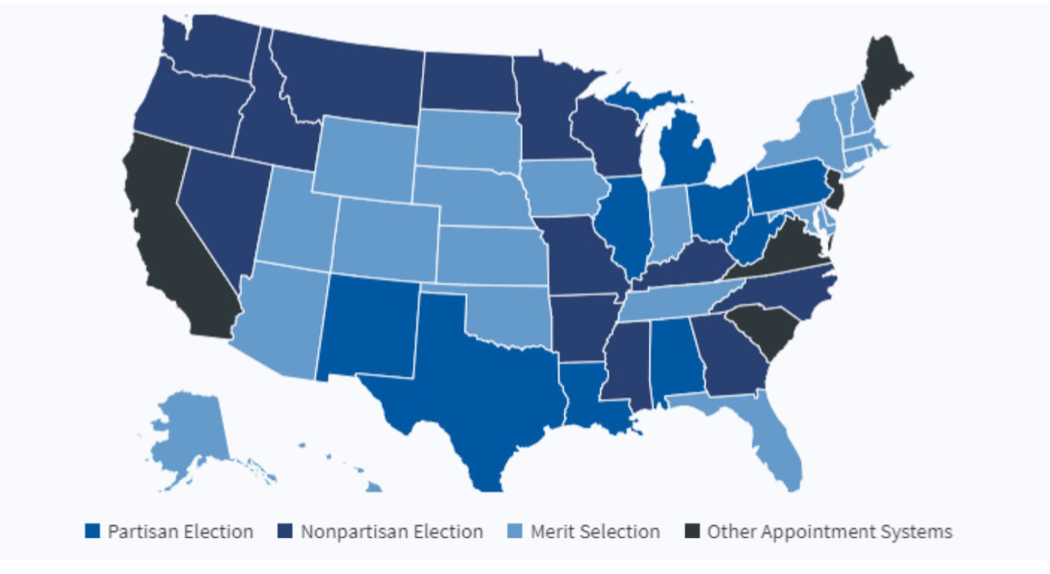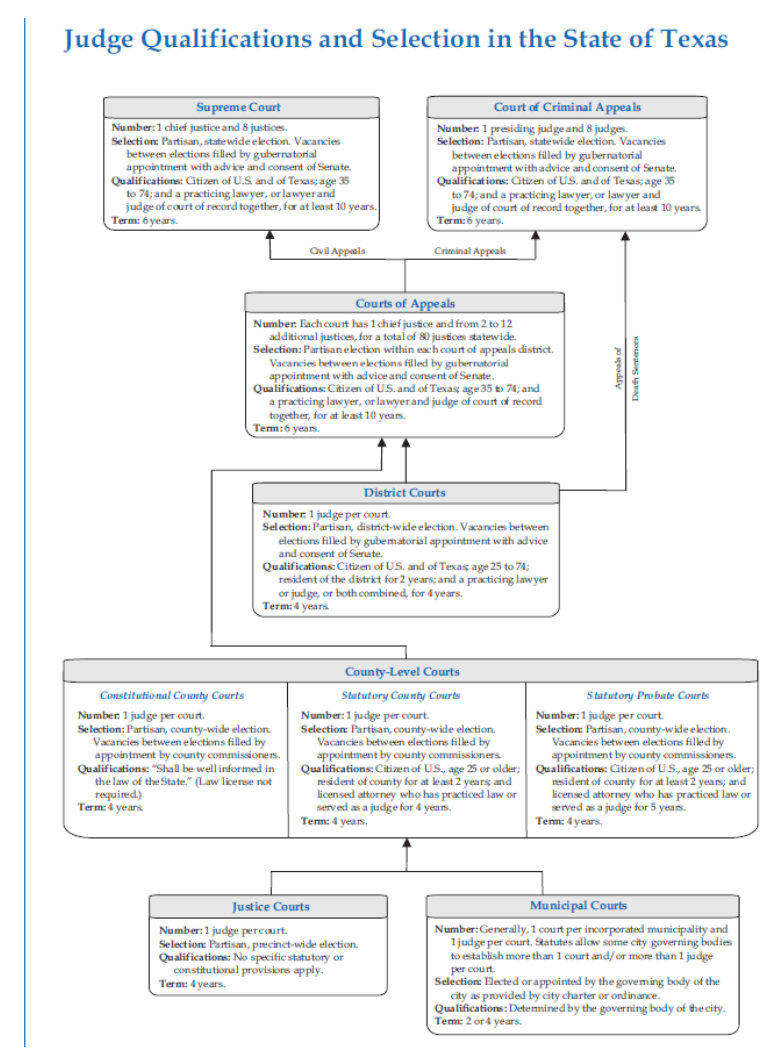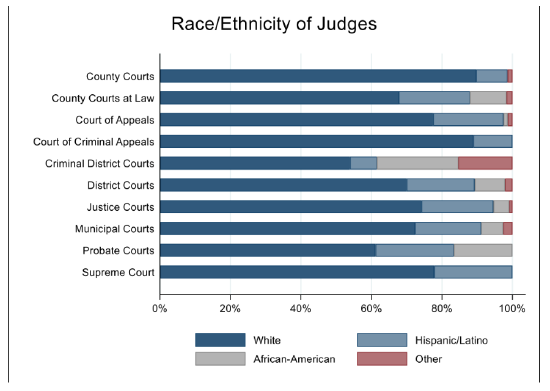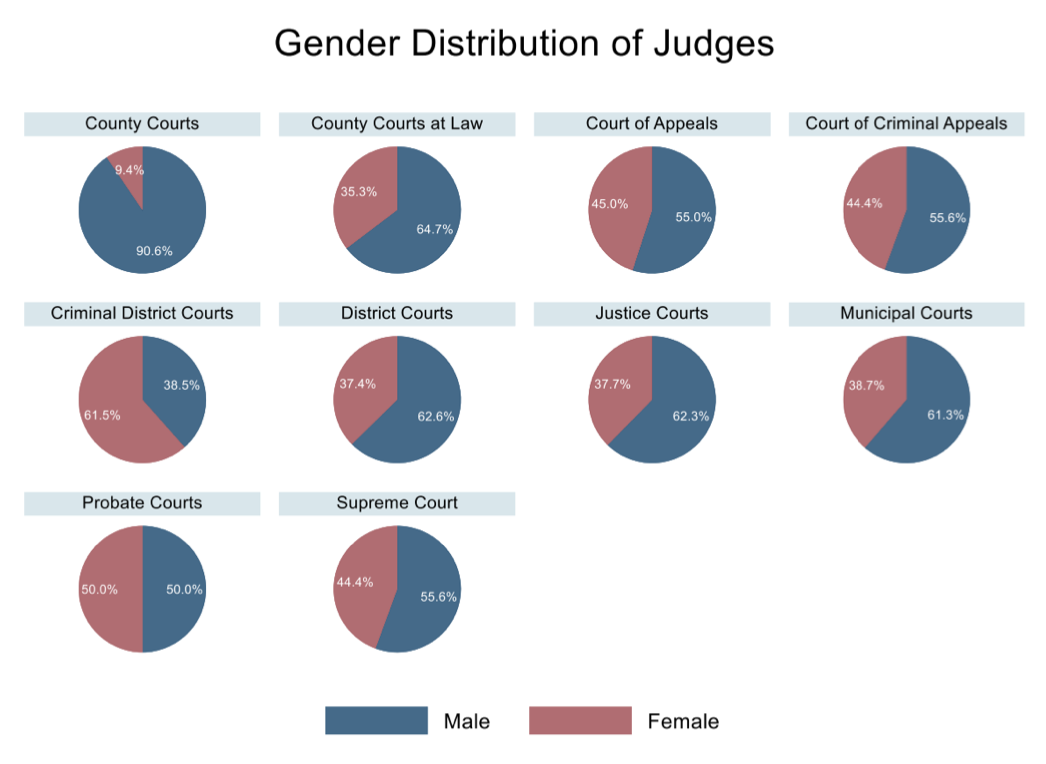9.4: Judicial Selection Processes
- Page ID
- 129223
Different states have different methods for selecting judges in the United States. Each state is unique, but there are five main methods.
- Partisan elections: Judges are identified by party affiliation on a ballot and elected by the people.
- Nonpartisan elections: Judges are elected by the people, but a party affiliation is not listed on a ballot.
- Legislative elections: The state legislature selects judges.
- Gubernatorial appointment: The governor appoints judges, though approval by the state legislature is sometimes required.
- Merit selection: The governor appoints judges from a list of recommendations based on their qualifications. Judges must then be elected to stay in office, a process called a retention election. The judge, who does not face an opponent, is removed from the position if a percentage of voters (often fifty percent) indicate that he or she should not be retained.41
Figure 9.7 demonstrates how these judicial selection methods are distributed throughout the country.

In the selection of judges to their highest courts, nine states use partisan elections and thirteen states use nonpartisan elections. In twenty-eight states, the governor or legislature initially appoints judges to the highest court, with twenty-one of those states using some form of merit plan. For the retention of judges on the state’s highest court, six states use partisan elections and fourteen states use nonpartisan elections. Eighteen states hold retention elections to determine whether those judges remain in office beyond their initial term, and the incumbent judges run unopposed and must win majority approval for retention. Nine states rely on reappointment by the governor, legislature or a judicial nominating committee. Only three states grant their highest court judges permanent tenure.
Texas is one of only six states where voters select their judges (except at some of the municipal levels) in partisan elections, and Figure 9.8 depicts the specifics relating to the judges for each level of court.

Arguments For and Against Partisan Elections
Proponents of judicial elections argue that this method of selection is the most democratic, allowing the people to have a direct voice in selecting judges. They believe voters are capable of selecting a judiciary that reflects their values and that they are entitled to that choice.42 Another argument put forth by proponents of this selection method is that affiliating judicial candidates with a political party efficiently communicates the candidate’s values and ideologies to voters.
Critics counter that the growing amount of fundraising in election campaigns gives special interest groups a foothold to manipulate the judiciary to their liking. It is undisputed that judicial elections, and particularly partisan elections, have become much more expensive in the last decade.43 Proponents of judicial reform contend that there are at least two ways in which campaign financing might be associated with judicial decisions in favor of campaign contributors’ interests. The first way is a “selection bias” among the set of judges who win election. More specifically, judges who are already ideologically or otherwise predisposed to vote in favor of certain interests are likely to draw campaign financing from business groups and, by virtue of those resources, are more likely to be elected. Secondly, critics claim, judges who are not ideologically or otherwise predisposed to vote in favor of certain interests might, whether intentionally—or, as one former judge put it, subliminally—cast votes in cases either to obtain financial support from those interests for their future campaigns, or at least to reduce incentives for opposition or attacks funded by those interests. Those skeptical of the process, include Ohio Supreme Court Senior Associate Justice Paul Pfeifer, who claimed “I never felt so much like a hooker down by the bus station... as I did in a judicial race. Everyone interested in contributing has very specific interests. They mean to be buying a vote.”44
Court Demographics
The stories of Chief Justice Collingsworth and Chief Justice Jefferson at the beginning of the chapter show how dramatically representation among justices has changed. Judges are the ones most likely to criticize the system of partisan election, however. Retired Chief Justice Wallace Jefferson participated in a study of judicial selection in 2021. He points out, “Judges can be elected even though no one knows who they are . . . so they vote based on the sound of your name.”45 To prove his point, Hispanic-sounding names did poorly in the largely White Republican judicial primaries and female names did well in the Democratic primaries.46 While Texas’s population is 41.2 percent non-Hispanic White, double that are White on the Texas judiciary (Figure 9.9). The numbers are better, however, for women (Figure 9.10).


In their final report on judicial selection Wallace noted the need for more diversity on the bench: “Recent tragic events that have triggering protests have captured a feeling of alienation feel plague our system of justice.”47
Though there is a long way to go, if partisan election of judges continues alongside the higher voter turnout of recent elections, a more diverse slate of judges will come with the Democratic label. In 2018, eighteen new judges were elected in Harris County, the “Black Girl Magic” slate, as they called themselves, flipping the appellate courts from Republican to Democrat.48 Seventeen of these judges are Black women. “The diversity of ideology of opinion on the courts will become greater, ant that will lead to more decisions that are more balanced, more fair and represent the people of Texas,” said Democratic Justice Meagan Hassan.49 James M. Douglas, Distinguished Professor of Law at Texas Southern University comments, “They are very accomplished lawyers, and I think the judiciary is going to be in good hands. . . . The most important thing is not that they are all Democrats, the most important thing is that they’re all good.”50
41. “The Case for Partisan Judicial Elections,” The Federalist Society, Jan. 8, 2018, https://fedsoc.org/commentary/public...ial-elections-
42. Billy Corriher, “Partisan Judicial Elections and the Distorting Influence of Campaign Cash,” Center for American Progress, Oct. 12, 2012, https://www.americanprogress.org/iss...campaign-cash/.
43. Paul Pfeifer, quoted in Joanna Shepherd, “Justice at Risk: An Empirical Analysis of Campaign Contributions and Judicial Decisions,” American Constitutional Society (June 2013): 6, http://lgbtbar.org/annual/wp-content...l-Analysis.pdf.
44. Emma Platoff, “Despite Committee’s Recommendation, Ending Texas’ Partisan Judicial Elections Looks Unlikely,” Texas Tribune, Dec. 31, 2020,
45. https://www.texastribune.org/2020/12...ions-partisan/
46. Platoff, “Ending Texas’ Partisan Judicial Elections,” https://www.texastribune.org/2020/12...ions-partisan/.
47. Texas Commission on Judicial Selection Final Report, Public Policy Research Institute – Texas A & M University (Dec. 2020): 9, https://www.txcourts.gov/media/14502...compressed.pdf.
48. Emma Platoff, “Democratic Male Judges May Be Headed for Extinction in Texas. The Cause? Voters,” Texas Tribune, March 9, 2020, https://www.texastribune.org/2020/03...ial-primaries/.
49. Emma Platoff, “Texas Democrats’ Biggest Win on Election Night May Have Been the Courts” Texas Tribune, Nov. 8, 2018, https://www.texastribune.org/2018/11...-beto-orourke/.
50. Brian Rogers, “Republican Judges Swept Out by Voters in Harris County Election,” Chron., Nov. 10, 2018, https://www.chron.com/news/houston-t...y-13376806.php.

